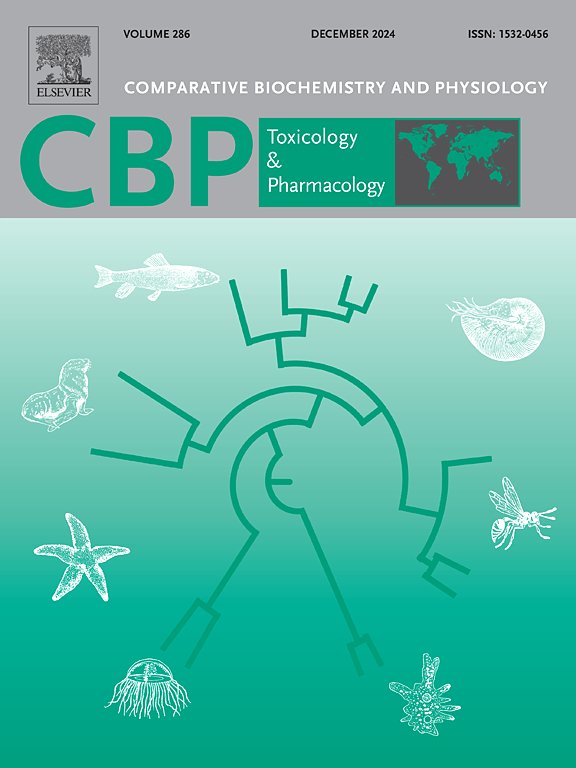Transcriptome-based analysis reveals the toxic effects of perfluorononanoic acid by affecting the development of the cardiovascular system and lipid metabolism in zebrafish
IF 4.3
3区 环境科学与生态学
Q2 BIOCHEMISTRY & MOLECULAR BIOLOGY
Comparative Biochemistry and Physiology C-toxicology & Pharmacology
Pub Date : 2024-12-07
DOI:10.1016/j.cbpc.2024.110108
引用次数: 0
Abstract
Perfluorononanoic acid (PFNA) is a perfluoroalkyl acid containing nine carbon chains, with an additional carbon‑fluorine bond that makes it more stable and toxic. Studies have shown that PFNA can harm the reproductive, immune, and nervous systems, as well as many organs, which can increase the risk of cancer. In this study, zebrafish embryos were treated with 0 and 100 μM PFNA for 72 and 96 hpf, and their angiogenesis and haematopoiesis were observed under laser confocal microscopy using Tg (fli1:EGFP) and Tg (gata1:DsRed) transgenic zebrafish. The data showed that PFNA exposure decreased heart rate and slowed blood flow in zebrafish. PFNA was found to inhibit erythropoiesis by O-dianisidine staining. RNA-seq analysis was used to compare gene expression changes in zebrafish from control and 100 μM PFNA-exposed groups at 72 hpf. KEGG results showed significant enrichment of PPAR signaling pathway, fatty acid metabolism, steroid biosynthesis and apoptosis. The RNA-seq results were validated by real-time fluorescence quantitative PCR (RT-qPCR). Oil red O staining and Filipin staining showed increased lipid accumulation after PFNA exposure, and TUNEL staining showed that PFNA exposure led to apoptosis. In conclusion, exposure to PFNA may cause toxic effects in zebrafish by affecting cardiovascular development, causing lipid accumulation and promoting apoptosis.

基于转录组的分析揭示了全氟壬烷酸通过影响斑马鱼心血管系统和脂质代谢的发育而产生的毒性作用。
全氟壬烷酸(PFNA)是一种含有九个碳链的全氟烷基酸,另外还有一个碳氟键,使其更稳定,毒性更强。研究表明,PFNA会损害生殖系统、免疫系统和神经系统,以及许多器官,从而增加患癌症的风险。本研究用0和100 μM PFNA分别处理斑马鱼胚胎72和96 hpf,在激光共聚焦显微镜下用Tg (fli1:EGFP)和Tg (gata1:DsRed)转基因斑马鱼观察其血管生成和造血情况。数据显示,PFNA暴露降低了斑马鱼的心率,减缓了血液流动。o -二苯胺染色发现PFNA有抑制红细胞生成的作用。RNA-seq分析比较对照和100 μM pfna暴露组斑马鱼在72 hpf下的基因表达变化。KEGG结果显示PPAR信号通路、脂肪酸代谢、类固醇生物合成和细胞凋亡显著富集。通过实时荧光定量PCR (RT-qPCR)验证RNA-seq结果。油红O染色和Filipin染色显示PFNA暴露后脂肪堆积增加,TUNEL染色显示PFNA暴露导致细胞凋亡。综上所述,暴露于PFNA可能通过影响心血管发育、引起脂质积累和促进细胞凋亡而对斑马鱼产生毒性作用。
本文章由计算机程序翻译,如有差异,请以英文原文为准。
求助全文
约1分钟内获得全文
求助全文
来源期刊
CiteScore
7.50
自引率
5.10%
发文量
206
审稿时长
30 days
期刊介绍:
Part C: Toxicology and Pharmacology. This journal is concerned with chemical and drug action at different levels of organization, biotransformation of xenobiotics, mechanisms of toxicity, including reactive oxygen species and carcinogenesis, endocrine disruptors, natural products chemistry, and signal transduction with a molecular approach to these fields.

 求助内容:
求助内容: 应助结果提醒方式:
应助结果提醒方式:


